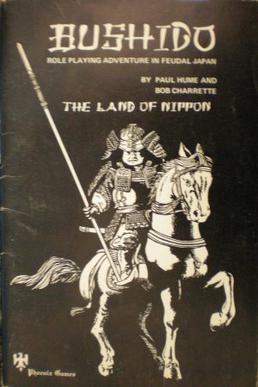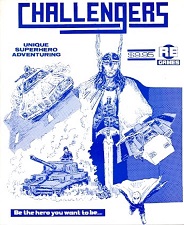
Star Frontiers is a science fiction role-playing game produced by TSR from 1982 to 1985. The game offers a space opera action-adventure setting.

Superworld is a superhero-themed role-playing game published by Chaosium in 1983 that uses the generic Basic Role-Playing rules system. The game began as just one part of the Worlds of Wonder product before being published as a stand-alone game. In competition against other well-established and popular superhero games, Superworld never found an audience, and was discontinued after only three supplements were published for it.
Traveller is a science fiction role-playing game first published in 1977 by Game Designers' Workshop. Marc Miller designed Traveller with help from Frank Chadwick, John Harshman, and Loren Wiseman. Editions were published for GURPS, d20, and other role-playing game systems. From its origin and in the currently published systems, the game relied upon six-sided dice for random elements. Traveller has been featured in a few novels and at least two video games.

Chill is an investigative and modern horror role-playing game originally published by Pacesetter Ltd in 1984 that captures the feel of 20th-century horror films.

Oriental Adventures is the title shared by two hardback rulebooks published for different versions of the Dungeons & Dragons (D&D) fantasy roleplaying game. Each version of Oriental Adventures provides rules for adapting its respective version of D&D for use in campaign settings based on the Far East, rather than the medieval Europe-setting assumed by most D&D books. Both versions of Oriental Adventures include example campaign settings.

The Palladium Fantasy Role-Playing Game is a fantasy role-playing game published by Palladium Books in 1983.

Mercenaries, Spies and Private Eyes (MSPE) is a tabletop role-playing game designed and written by Michael A. Stackpole and first published in April 1983 by Blade, a division of Flying Buffalo, Inc. A second edition was later published by Sleuth Publications in 1986, but Flying Buffalo continues to distribute the game. In 2019 a new revised Combined Edition of MSPE was published by Flying Buffalo which brought the different material from the previous editions and included additional new rules and expansions to the original rpg. MSPE's mechanics are based on those of Tunnels and Trolls, with the addition of a skill system for characters. A few adventure modules were also released for MSPE.

Bushido is a Samurai role-playing game set in Feudal Japan, originally designed by Robert N. Charrette and Paul R. Hume and published originally by Tyr Games, then Phoenix Games, and subsequently by Fantasy Games Unlimited. The setting for the game is a land called Nippon, and characters adventure in this heroic, mythic, and fantastic analogue of Japan's past.

Powers & Perils (P&P) is a fantasy role-playing game published by Avalon Hill in 1984. The highly complex game was Avalon Hill's first foray into the role-playing game market, and proved to be a commercial failure.

Daredevils is a tabletop role-playing game published by Fantasy Games Unlimited (FGU) in 1982 that is meant to emulate pulp magazine fiction of the 1930s.

Lords of Creation is a multi-genre tabletop role-playing game published by Avalon Hill in 1983. Although expectations were high when Avalon Hill entered the role-playing game market, the game failed to find an audience and was discontinued relatively quickly.

High Fantasy is a fantasy role-playing game system originally published by Fantasy Productions in 1978. A second edition in 1981 and several subsequent books were published by Reston Publishing that featured solo adventures using the High Fantasy system. The game received mixed reviews in game periodicals including White Dwarf, The Space Gamer, Different Worlds, Ares, and Dragon.

Timemaster is a role-playing game centered on traveling through time and alternate dimensions, published by Pacesetter Ltd in 1984. Players take on the role of Time Corps agents who fix deviations in the timeline of the game. The primary antagonists are the Demoreans, a fictional race of shape-shifting aliens from another dimension who are determined to mold time to suit their needs.
Thieves' Guild is a fantasy role-playing game published by Gamelords in 1980.

Dream Park: The Roleplaying Game is a role-playing game published by R. Talsorian Games in 1992. It was designed by Mike Pondsmith and was based on the 1981 novel Dream Park, which is itself about a live-action role-playing game amusement park. The player characters take on the roles of the players in this holographic game, simultaneously playing both the character and the character's alternate persona.

Challengers is a role-playing game published by Ragnarok Enterprises in 1985.

Ysgarth is a fantasy role-playing game published in 1979 by Ragnarok Enterprises. Several editions were subsequently published over the next twenty-five years.

Expendables is a science fiction role-playing game published by Stellar Games in 1987 in which the players take on the roles of interstellar explorers
Abyss was a gaming magazine first published in 1979, edited by Dave Nalle and published by Ragnarok Games. It was headquartered in Washington, D.C. and was published until 1984.

London by Night: Adventure in a Victorian City is a sourcebook published by Ragnarok Enterprises in 1984 as a supplement to the multi-genre role-playing game To Challenge Tomorrow. The book provides details about life in the city of London during the 1890s, as well as some mini-scenarios.
















